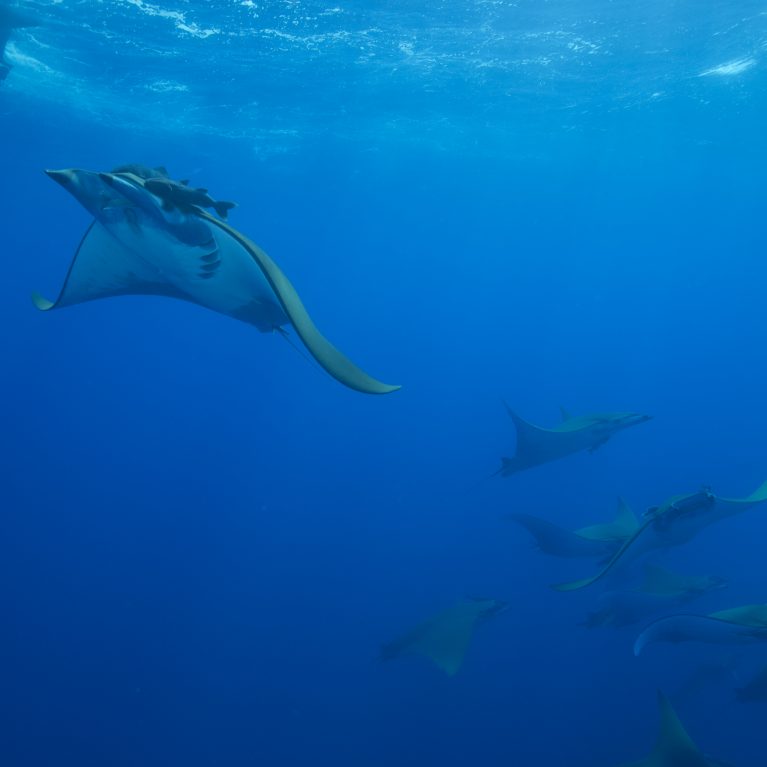Catching devils on camera
The Azores is one of the few places on earth where Chilean devil rays gather in large groups. We know that these rays are among the ocean’s deepest divers, but otherwise they remain a mystery to us. What will researchers discover with the use of remote underwater video stations?
I grew up on the southern coast of Portugal, a small country with an immense coastline facing the Atlantic Ocean. My connection with nature, and the ocean in particular, was evident from a very early age. By the time I was five, I knew I wanted to be a marine biologist (although for a short time I did consider a career as an astronaut). My desire to become a marine biologist stemmed from wanting not only to learn more about the marine environment, but also to work towards its conservation.
As I grew, so did that passion and by 2010 I...


Azores Seamounts, fringing aggregation sites for Mobula tarapacana in the Atlantic
This project aims to provide baseline information on temporal patterns of occurrence of the Chilean devil ray in Azorean seamounts using video observatories located on the main aggregation sites. Site fidelity will be studied by means of photo-identification using photos provided by divers and dive operators.
Considering the Chilean devil ray’s highly migratory nature and current vulnerability, understanding its ecology and behaviour is necessary to support sound management and conservation actions. Since most aspects regarding its ecology and biology remain unknown, these aggregations provide unique opportunities to study these animals using new and non-invasive techniques. Also, with the rapid growth of the mobula diving industry in the region, it is important to assess the impacts of this activity in these very specific aggregation sites and understand their ecological role.
The Chilean devil ray M. tarapacana is probably circumglobally distributed in temperate and tropical waters, but is known from scattered locations in the Indian, Pacific and Atlantic Oceans. It is primarily oceanic, and one of the least known mobulids. Our knowledge on the basic ecology of M. tarapacana is extremely limited, especially in terms of its habitat patterns, migration routes and aggregation dynamics, as well as the drivers of their distribution. Like other species of mobulids, M. tarapacana aggregates at specific locations, a behaviour that has been poorly studied.
The Azores seems to be one of the few locations in the world where M. tarapacana aggregates in such large schools. Here this species is known to aggregate seasonally at different locations where they can be observed in large schools of up to dozens of individuals. These aggregations appear to occur consistently in warmer months, when the water temperatures are higher, and in specific offshore locations. The highly predictable spatial and temporal nature of these aggregations, coupled with the curious behaviour of these animals, supported the rapid development of a directed mobula diving industry.
Unfortunately, it is economically and logistically impossible for researchers to regularly conduct underwater visual censuses due to the fact that these aggregations are located in remote places. Therefore, citizen science can be a valuable alternative for obtaining relevant ecological information, in particular, by enrolling dive operators to collect data on the occurrence and abundance of these species, but also through the submission of divers’ photos. In addition, underwater observatories have been widely used and have proven valuable in the study of remote or inaccessible ecosystems or species. They can range in complexity and persistence, from deep-sea image landers to long-term wired or wireless observatories with multidisciplinary instruments.
The aims and objectives of this project are to:
- Determine the seasonal patterns of abundance and behaviour of mobulids at Azorean seamounts.
- Analyse the impact of dive operations on mobula behaviour by comparing behaviours in the presence and absence of divers.
- Provide reliable information to support local government management and conservation efforts, including mobula-specific diving regulations and carrying capacity.
- Raise awareness among the public through the use of citizen science and the media.

